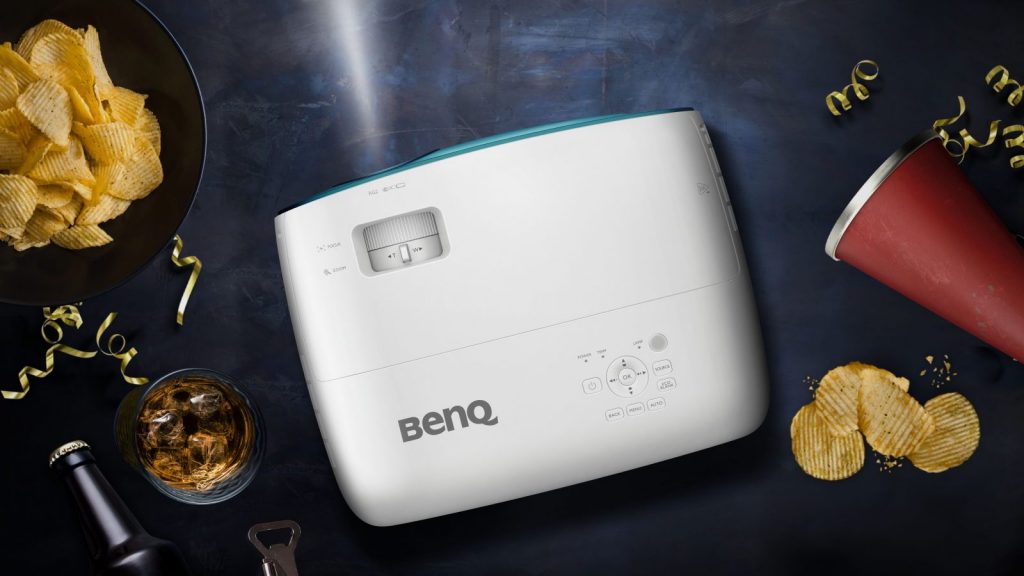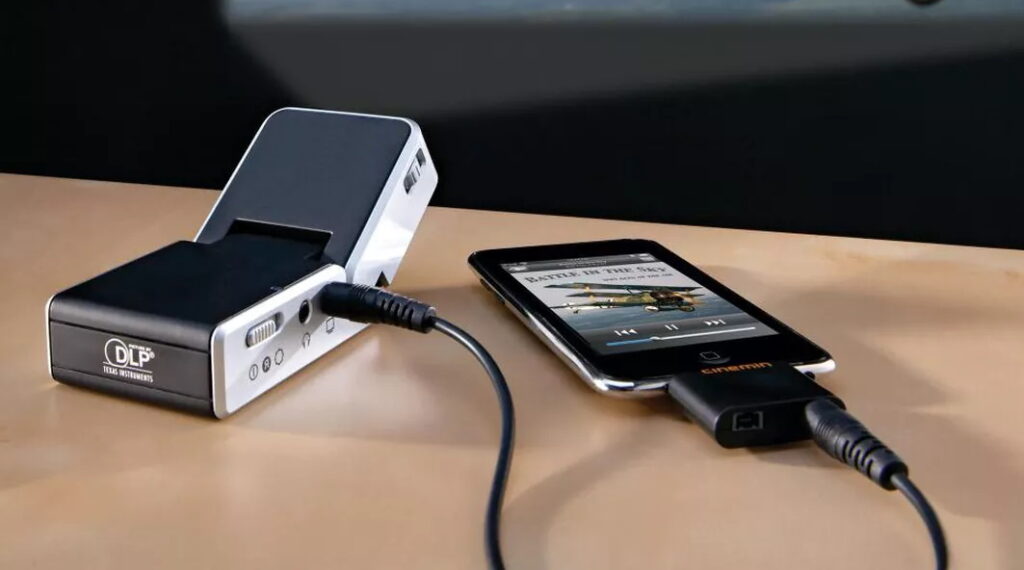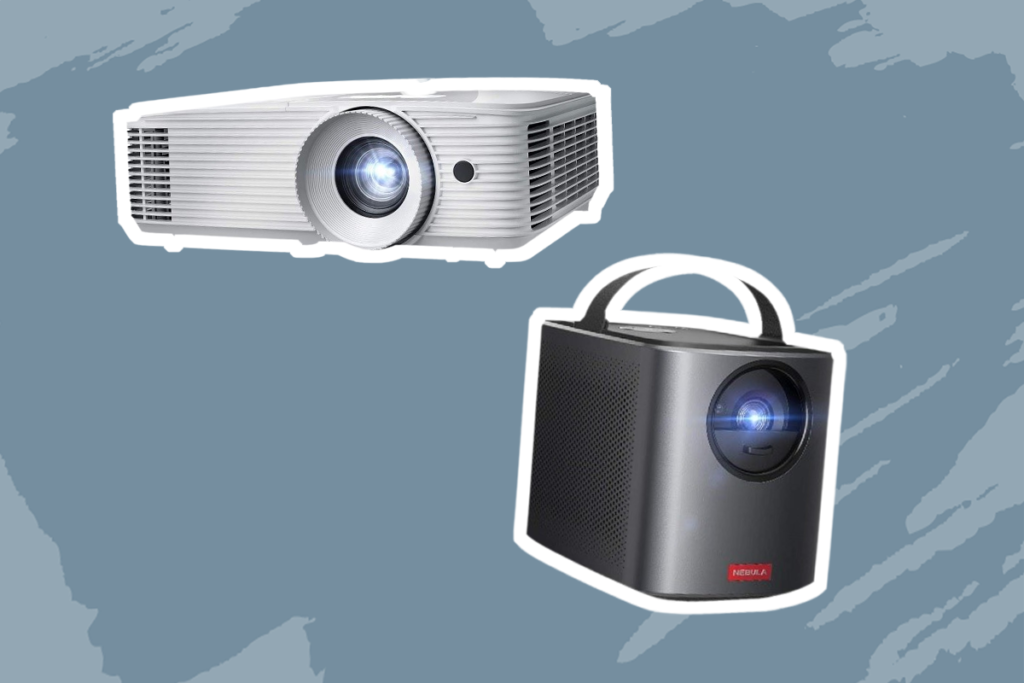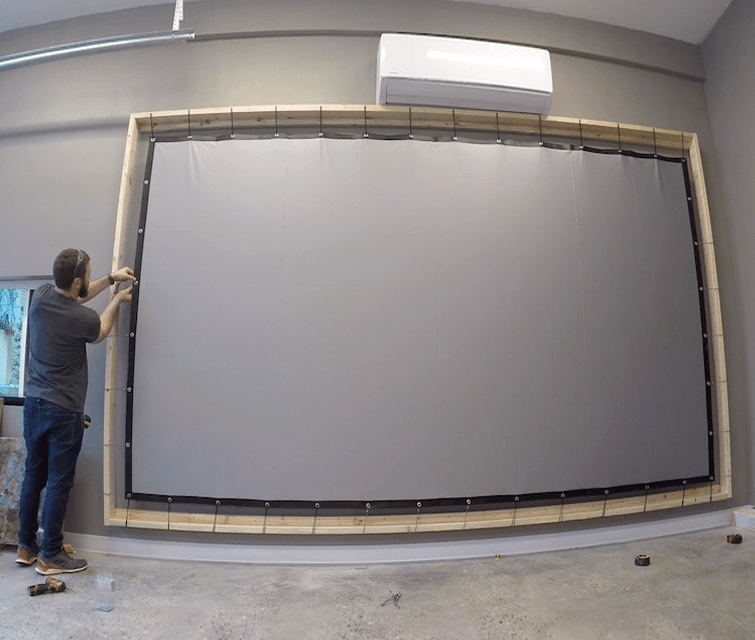Unlike a 2D projector, the best 3D projector creates images with depth that simulate a real-time action for a true cinematic experience. A home theatre with a 3D function is the easiest way to bring the cinema to your home and watch your favorite characters come to life.
To determine the best 3D projectors on the market, we’ve reviewed the most important features, such as display technology, brightness, contrast, and resolution. The type of display technology has an impact on the clarity, contrast, and resolution of the projected image, while the projector’s brightness and contrast affect the level of magnification and clarity of the final image. The resolution, which refers to the number of pixels, is an important feature because it determines the quality of the image. The results of our research from expert reviews and customer experiences were summed up in this article on the 5best 3D projector models, where the Optoma HD142X is our favorite one.
More features: can display 3D content from almost any 3D source, including 3D Blu-ray players, 3D broadcasting and the latest generation games consoles
This projector’s compact size, incredible contrast, full-HD resolution and longer lamp life makes it probably the best 3D projector under $1000 on the market today.
This Optoma HD142X uses DMD-chip DLP technology to generate images of up to 305.5 inches with a maximum resolution of 1920 x 1080 pixels at a throw ratio of 1.48:1 to 1.62:1. A backlit remote control is included which is useful in dimly-lit rooms and the fan runs quietly at less than 65 decibels to prevent distractions.
The programmed settings include Cinema, Gaming, sRGB and Reference, with variable power modes of Bright, Eco and Dynamic. You can select the Eco-mode to prolong the 8,000 hours of lamp life.
The 3,000 lumens output can withstand high ambient light for you to watch anything at any time of the day. The RGBCYW color wheel combined with BrilliantColor technology results in color-accurate images with a contrast ratio of 23,000:1, one of the highest ratios among the best budget 3D projectors.
Weighing only 5.5 pounds, it is one of the most portable 1080p projectors. It has USB, HDMI, MHL and wireless connectivity, but lacks the AV input found in majority of projectors.
It works with any 3D sources, whether 3D Blu-ray players or game consoles and 3D broadcasting. DLP Link glasses are purchased separately for 3D viewing.
More features: Football & Sport modes with Cinema Master Audio+2
Cinema enthusiasts, sport lovers and gamers will love the Vivid TV, Football, Bright, Cinema and Sport built-in modes of this projector as well as its custom user modes which can be adjusted according to your personal preferences.
Featuring DLP (Digital Light Processing) display used in digital cinemas, it has a contrast output of 10,000:1 and a brightness rating of 3000 lumens which can hold its own against other sources of light such as light bulbs and natural light. The lumen output can be reduced by 55% – simply turn off the Brilliant Color feature. However, unlike most of the DLP projectors, the feature does not have an incremental 1 to 10 scale. Lumen output can also be reduced by 36% using the economic lamp mode.
By using an RGBW color wheel which boosts white lumens and increases brightness by 30%, it decreases washing out of resulting images and adds more pop.
The Ultra HD 4K 3840 x 2160 projector uses XPR pixel shifting to generate a high resolution of 8.3 million pixels with a throw ratio ranging from 1.47:1 to 1.76:1, and a screen size of up to 300” which is suitable for practically any living room.
At only 9.3 pounds, with an integrated Cinema Master Audio+2 speaker and a crispy clear image, it is one of the best 1080p 3D projectors.
This projector comes with a convenient remote control with backlit keys. It uses 0.47” single-DMD-chip DLP technology which prevents the convergence inaccuracies found in LCD and LCoS models and is also immune to heat damage. It is also one of the few Ultra HD 4K projector models that support not only HDR, but also 3D, so its a fantastic option as a gaming projector.
Buyers have reported a white halo around the picture on the screen which the manufacturer attributes to the single-chip design.
More features: operates at 29 dB – 37 dB; up to 7,500 hours of lamp time
This is the best value 1080p 3D projector on the market. Unlike most projectors under $1000 which use DLP, this model uses three-chip LCD design which is immune to the rainbow disadvantage.
In addition to offering high definition at the full native 1920 x 1080 resolution, balanced images and compatibility with Mobile High-Definition Link and high definition 3D, it has other features that are usually found in premium models. This includes conversion of 2D to 3D, frame interpolation and image enhancement.
The projector has a built-in five-watt mono speaker with advanced noise reduction and an audio-out port which allows you to amplify the sound with external speakers for your home entertainment. Gamers will love the frame interpolation which eliminates blurs and the short lag time of 25 milliseconds which is an asset when the reaction time is crucial. Unfortunately, you can’t use both simultaneously because frame interpolation increases lag time.
Image balance is enhanced by a contrast output of 35,000:1 and a brightness output of 2200 lumens which is unaffected by ambient light. The 1.2x zoom feature makes the throw ratio ranging from 1.22:1 to 1.47:1 more flexible for a 332-inch diagonal projection.
Various preset picture modes are available to customize your viewing. On energy-saving mode, the light lamp can last up to 7,500 hours.
The noise level ranges between 29 and 37 decibels, which is quieter than a normal conversation.
For 3D viewing, you have to purchase 3D glasses separately.
More features: vertical keystone function; composite, S-Video, 2x HDMI, 2x VGA In
Touted as ideal for business and education purposes, this projector has the audiovisual ports required to serve a small classroom or conference room. It features S-Video function, composite video output, two VGA and two HDMI inputs which allow multiple users to connect simultaneously using computers or HD devices.
Using DLP technology, it projects images measuring between 30 to 300 inches diagonally with a resolution of 1280 x 800 pixels. The built-in settings include three brightness modes and four color modes for a more personalized experience.
The mercury lamp, which operates at 210 watts, has a maximum brightness output of 3,600 lumens which can withstand the effects of ambient light to prevent washed out images, illegible text and color distortion. Lamp life can be extended by selecting the Eco Blank mode which saves 70% of power.
In addition to the contrast output of 15,000:1, this projector has a vertical keystone feature which allows you to correct misalignment in the projected image into the ideal square form.
The throw ratio ranging from 1.55:1 to 1.86:1 offers you variety on where to place the projector while the 1.2X zoom feature optimizes the available space.
Although we did not expect a stereo out of this model due to its designation for a more formal environment, we still found the built-in two-watt speaker barely audible. You would have to use external speakers to improve the volume.
More features: 2-year warranty, +40 degrees keystone correction, HDMI and WIFI compatible
This is a supermini portable projector with the DLP display technology and an internal battery. It’s a portable projector which you can use on the go. It also supports 1080p and 3D video. The projector has a contrast of 1,000:1 which makes it great for home entertainment. There’s also a native resolution of 1920 x 1080 px. You will also have up to +40 degrees keystone correction.
Compatible with WiFi and HDMI, the device can be charged via the included micro USB. It’s a very standard cable which means if you’re going to be bringing this on the go with you, then you don’t have to bring a special cable with you.
It includes a very hefty owner’s manual and an included tripod. It’s a very small projector that has a dimension of about 4 by 4 inches with around an inch thick. You could almost fit this in your pocket. It’s going to be very easy to travel with or mount anywhere. The mini projector is compatible with an iPhone, Android, and laptop for your home and outdoor entertainment.
The internal battery is 5200 milliamp hours. It has a 3 amp wall adapter plug so you can use this for your phone as well. The projector also comes with remote control with a power button menu, a 3D button, volume controls, a zoom button, a home button, and then you have the directional controls with an OK button. It’s a very light and cheap feeling remote control.
The projector has some casting abilities from iOS and then Miracast including media and HDMI. By connecting it to a WiFi connection, you can communicate with the Internet and do things such as stream YouTube.
In addition to detailed reviews of the important features, this buying guide explains the benefits of 3D projectors and offers tips on how to set them up for an enjoyable theatre-like movie night. The last section answers some of the most frequently asked questions for additional clarity.
3D projectors add depth to the images to make them more life-like and realistic. This is useful when explaining complicated designs in architecture and education. The resulting pictures also have better resolution and superior quality with less blurring of motion.
These projectors also allow you to configure and increase the image on your screen to simulate a real-life theatre, or bring your favorite character to life.
Additionally, larger images are more comfortable to view with 3D projectors which reflect light as opposed to ordinary televisions which emit light. They also reduce eye strain.
Lastly, they allow us to maximize space since most projectors are compact in size and can be mounted on ceilings. You can also take them with you anywhere due to their light weight. They can work with multiple devices such as VGA, SD, HDMI, wireless, MHL and AV, among others.
In summary, 3D projectors are a good investment which provide an awesome cost-benefit ratio.
Paying attention to the following features when shopping for the best 3D projector will help you make the best selection and optimize your viewing experience. They are the features that bring the “pro” in 3D projectors.
There are two main types of display technologies used in modern 3D projectors; DLP and LCD.
DLP technology which is featured in BenQ TK800 is the most common type used in projectors and movie theatres. It utilizes micro mirrors and a color wheel to produce brighter images than LCD with less motion blur due to low lag time, but less vivid black than LCD. It is also prone to the rainbow effect since it uses a color wheel.
LCD uses technology that is similar to the one in televisions and does not consist of moving parts, unlike the mirrors and color wheel in DLP projectors. LCD makes use of high-intensity light beam for more vivid black images and better contrast.
Using three-chip design in 3DLP and 3LCD, as opposed to a single-chip design, offers the most superior quality with better color saturation as seen in Epson Home Cinema 2040. This technology is mostly found in high-end models.
Brightness is one of the most important attributes in a 3D projector and one of the distinguishing features of affordable and expensive projectors. A projector can never be too bright since it is always easier to reduce its brightness than to increase it.
Brightness is measured in ANSI lumens. The number of lumens should be determined by the amount of ambient light in your viewing room as well as the size of your screen. The more the light and the larger your screen, the higher the level of brightness required. Generally, a projector with a minimum of 3,000 lumens would suffice in most situations.
Contrast ratio is calculated by comparing the difference in brightness between black and white images, with a high ratio indicating greater quality of pictures with better color and clarity. The entry-level VANKYO Burger 101 has a contrast ratio of 2,200:1 while Epson Home Cinema 2040 has 35,000:1.
Resolution refers to the number of pixels that can be transmitted, with a high number yielding pictures with finer and more extensive details. For instance, the BenQ TK800, a 4K projector, has an incredible resolution of 3840 x 2160 pixels.
Keystone correction allows you to align and position the projected image horizontally, vertically, or diagonally into the correct rectangular image when your projector is placed at an angle to the screen instead of perpendicular to it. The amount of correction differs in degrees from one model to another.
Throw distance refers to the distance between your screen and the projector while throw ratio refers to the throw distance compared to the width of your screen, which is denoted as throw distance divided by the width of the screen.
For instance, BenQ MW535A has a throw ratio of 1.55:1 – 1.86:1. This allows it to project 120 inches from as close as 13 feet. If you don’t have much room, then an ultra short throw projector will work best.
Screen size refers to the diagonal distance of your screen and is measured in inches. When it comes to screen size, bigger is always better. Knowing the ideal size of the screen will help you choose the right projector because the amount of magnification varies from one model to another and using the wrong projector may magnify the image but decrease its brightness.
Also called a lamp, a bulb refers to the source of light. Projectors use lamps with LED, metal halide, or LED/laser technology for illumination. The bulb life can range from 2000 to more than 4000 hours in metal halide projectors and 20,000 hours in LED projectors.
Laser models are the brightest, followed by metal halide lamps while LED lamps are quieter with better colors and a longer lifespan than metal halide lamps.
Since lamp warranty starts from purchase day and not usage day, it is best to test it out as soon as you buy it in order to replace it in case it is defective. Warranty also covers dead pixels, by the way.

Weight: A projector that is light in weight provides convenient portability and storage. You can mount it anywhere and have entertainment on the move. Luckily, majority of 3D projectors are relatively light.
Dimensions: Similar to weight, a compact size improves portability and can fit easily in limited spaces.
Built-in speaker: Although projectors are not loud enough to be used as home theatres on their own, an integrated speaker can easily be paired with external ones or home theatre to amplify it. Some feature enhanced audio enhancements for better sound. VANKYO Burger 101 has SRS Sound System to improve the sound quality.

Optoma HD142X is our best 3D projector on the list which strike a nice balance of affordability, portability and quality entertainment. It has brightness output of 3,000 lumens, multiple ports, a variety of picture modes and up to 8,000 hours of lamp life.
BenQ TK800 is the best 3D home projector for both gamers and movie enthusiasts, with its XPR pixel shifting technology generating a high resolution of 8.3 million pixels and a contrast output of 10,000:1. Furthermore, it features multiple picture and color modes and built-in Cinema Master Audio+2.
In addition to using the three-chip LCD design which is immune to the rainbow effect, Epson Home Cinema 2040 has advanced features like 2D to 3D conversion, frame interpolation and image enhancement, which effortlessly makes it the best 3D projector under $1000. It also has a high contrast output of 35,000:1, short lag time, a built-in speaker and a zooming function.





